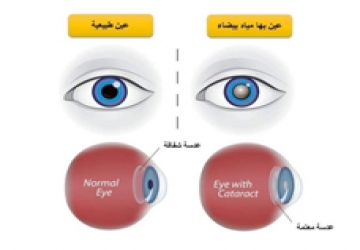
cataract
It is the opacity of the crystalline lens of the eye and leads to poor vision.
Cataract types and causes
1.Cataract associated with old age (cataract of old age).
2.Congenital cataract, which is what occurs from birth.
3.Cataract resulting from some eye diseases such as iritis and retinal detachment.
4.Cataract from eye injuries.
5.cataract resulting from the prolonged use of some medications such as cortisone.
symptoms
The main symptom of cataract is gradually diminishing vision with blurred reading.
medications
To this day, there are no medications or drops that prevent cataracts, and the only treatment is cataract removal with an intraocular lens implant.
ways to remove cataract
1.Phaco: Cataract suction after breaking up the opaque lens with ultrasound with a reciprocating or vibrating movement through tiny surgical openings, then folded lenses are implanted through these tiny openings inside the eye and the operation does not result in any astigmatism after the operation.
2.femtocataract: in which the femtosecond laser is used to break up the cataract and make very fine openings in the cornea. The surgeon sucks the cataract through it, and the femtolizer is also used to correct astigmatism during the operation.
3.Surgical removal of the cataract: This is done without breaking up the opaque lens through a relatively large surgical opening, then the lens is implanted through this opening.
When should cataract be removed?
Advice of Dr. Muhammad Hantira Assistant Professor of the Ophthalmology Department _ Umm Al-Qura University_ Saudi Arabia
Usually we remove cataracts when the density of opacity impedes vision to a degree that hinders the patient's performance of his usual activities such as working and driving, which varies from patient to another